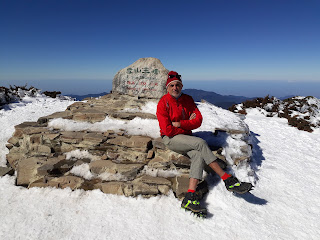Xueshan (雪山; 3,886m), Heping District, Taichung
At first sight, Xueshan (雪山), literally meaning “Snow(y) Mountain”, would seem to be named for its appearance since, in winter at least, its higher sections are indeed snow-capped.
> ......................... On the summit of Xueshan in winter (photo copyright JYP)
As so often with Taiwan’s toponymy, however, things may not be so straight-forward. For the Atayal (泰雅) aborigines, to whose traditional hunting grounds this area belonged, it was known as:
i) B'bu' Hagay meaning “Stone Mountain” for the sandstone rocks poking through the snow;
ii) Mahamayan, which sometimes appeared in Chinese texts transliterated as 馬哈馬顏山 (Mdn. Ma-ha-ma-yan Shan); or
iii) Sekoan, meaning “gravel and cracks”.
It is this last that may well be the origin of today’s name, since another early Chinese name for the mountain was 雪翁山, meaning “Snow(y) Old-Man Mountain” ( or 雪高翁山; “Snow(y) High Old-Man Mountain”). Pronounced something like Seh-ang-soaⁿ in Hoklo Taiwanese, it is suggested as a possible transliteration of the Atayal Sekoan. [MC: Since Hoklo words pronouned "sek" would be available, perhaps it might be considered a "rough transliteration using characters with suitable meanings".]
> ........................ Xuashan's main peak (photo Peellden, Wikipedia commons)
Confusingly, in some early texts it was also called 玉山 (Mdn. Yushan; “Jade Mountain”). Yushan was eventually chosen as the name of Taiwan’s highest mountain, located on the border of Nantou County's Xinyi Township, Kaohsiung City's Taoyuan District, and Chiayi County's Alishan Township.
In 19th-century English-langauge texts it appeared as “Mt. Sylvia”, named by the captain of the British gunboat “Sylvia” who spotted the mountain when sailing through the Taiwan Strait in 1867.
As Taiwan’s 2nd highest mountain at 3,886m above sea level and, therefore, higher than Mt. Fuji (3,776), during the Period of Japanese Rule (1895~1945) it became known as Tsugitakayama (次高山; lit. “Next [i.e., 2nd] Highest Mountain”).
In the postwar period, President Chiang Kai-shek renamed it 興隆山 (Mdn. Xinglong Shan; lit. “Prosperity Mountain”) but, unlike so many of his namings, this one did not stick.
(main source: Wikipedia)
Copyright Jiyue Publications 2022



No comments:
Post a Comment